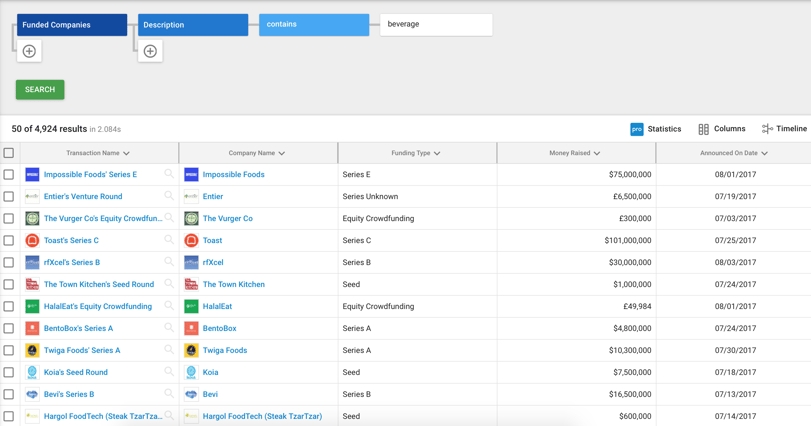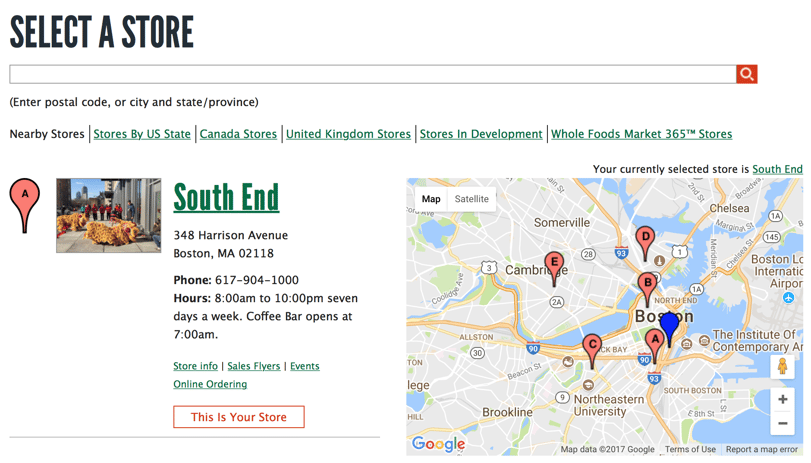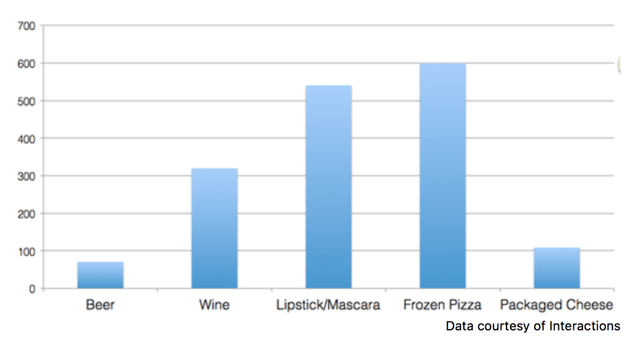“I’d love to help you out, but I’m not sure how you’re different from what I’ve already got in the snack aisle.”
Hearing the word “no” is never easy (especially in sales), but it’s even worse when you know you only lost because one of your competitors beat you to the punch. Maybe that’s because bad blood from previous turf wars never really fades away, or maybe because it’s all too easy to imagine yourself in their shoes, winning the deal.
I tend to think it’s because having your competitor win a deal over you is actually a sign of just how close you were. If a competitor gets on the shelf, it means the category was ready for you and a retailer saw the value in a product like yours. It means the line between owning the endcap and leaving the store empty-handed was razor thin.
Luckily, what makes it so painful is also the silver lining. When you’re that close to landing a placement, taking just a few extra proactive steps can give your brand the edge during your team’s next pitch or store visit. And when you’re forced to fight tooth and nail for market share and brand recognition, every victory counts.
If you’re feeling the heat from your competitors (or even just hearing “no” more often than usual — sometimes an early sign one of your competitors is on the rise), here’s how you can stay a step ahead and keep winning for your brand.
Know Thine Enemy
“If you know the enemy and know yourself, you need not fear the result of a hundred battles. If you know yourself but not the enemy, for every victory gained you will also suffer a defeat. If you know neither the enemy nor yourself, you will succumb in every battle.”
Sun Tzu, The Art of War
Sure, fighting for space on the shelf might not be as dramatic as the war Sun Tzu had in mind, but still - understanding who it is your sales team is fighting against is critical if they’re going to start (or keep!) winning their pitches.
To do that, the first step has to be doing your homework and researching your segment. I know, it sounds boring, but it’s a bit like learning the fundamentals of a sport, or learning to walk before you can run. It might be obvious, but without some insight on your competitors, you can’t expect your team to perform at the highest level.
When digging up information on the brands that have their eyes on the same shelf space as you, think about more than just who’s on the rise in your segment. Dive into the reeds. Look for brands that just raised funding or landed big distribution partnerships. Try to find out who’s especially active in your most important territories, or in the chain or store segment your team is targeting.
Crunchbase
While that’s a lot of data to hunt down, the good news is that you can do a lot of it right from your computer. Sites like Crunchbase report recent fund raises, and allow you to filter results by industry or location. You can do basic searches for free, or you can upgrade to add multiple filters and advanced sorting and export options.

Store Locators
When setting your sights on a specific retailer, you can sometimes find a list of all of the brands and products they carry — by individual store location — online. For example, Whole Foods links to these lists from each store’s page on its website.
From the Whole Foods Store Locator, simply enter your target zip code or choose a store location from the map. Then, click the “Store Info” link below the hours of operation. From there, you’ll see a section on the right ride of the page titled “Unique to This Store,” where you can find lists to every product on the shelf under that Whole Foods’ roof, organized alphabetically and by category.

Lists like these make it easy to predict which companies already have a foothold in the stores you’re targeting, so you can create a plan for your team to sell against them.
Competitive Audits
Pulling lists online is great, but it ignores one massive resource sales managers have at their disposal — the team of sales reps that are visiting stores and seeing competitors every day. It’s one thing for your reps to see competitors on the shelf every time they visit a store, but it’s another challenge altogether to get that insight from them and analyze it in a meaningful way. Not to mention, very few salespeople want spend their time on anything but selling during the workday.
What sounds like a tough problem actually has a pretty simple solution: having your sales staff run competitive audits during store visits. With a relatively quick setup, a good competitive audit process gets you accurate information about which competitors are on the shelf in which stores, as well as what kind of pricing and promotions they use in the store to get off the shelf — everything you need to create a competitive selling strategy.
The key to a good competitive audit is to be organized. Otherwise, it’ll become a frustrating task for your reps, and a chore for you to make sense of. But if you create a simple checklist of questions your reps should answer about the competitors they see on the shelf, and give them an easy way to share that info with you (we might be biased, but we think the Repsly app is a perfect tool for that), then it’ll only take a minute or two out of every visit. In return, you get everything you need to create a targeted sales plan for every account your reps visit.
For more details on how to build a competitive retail audit, check out our step-by-step advice in this blog post.
Pump Up Your Shelf Velocity
“Hence that general is skillful in attack whose opponent does not know what to defend; and he is skillful in defense whose opponent does not know what to attack.”
Sun Tzu, The Art of War
I kind of like where this Art of War analogy is taking us, so let’s keep it up. According to our friend Sun Tzu, going up against your opponents is as much about skill as it is about force, and sales managers should have a number of tools ready to call on when competing with other brands.
Successful sales managers don’t just focus on winning competitive sales to retailers, but also on helping move their products off the shelf faster than their competitors. Not only does focusing on shelf velocity put sales teams in position to place more replenishment orders, but it can be a huge component of future competitive pitches, and can also win you additional placements throughout the store.
With that in mind, sales managers who are constantly on top of their category are thinking both about winning pitches and winning on the shelf.
Here are a few tools you can add to your arsenal to get your product off the shelf faster and sell more:
Win The Price Tag Battle
If you have the flexibility to negotiate your products’ retail price with buyers, you can take advantage of creative pricing strategies to make your brand more desirable than its neighbors on the shelf. This goes far beyond just being cheaper than your closest competitor, though. In fact, it’s equally as important to realize when you might be able to charge more for your products without seeing sales suffer.
The trick here is to understand the way the human brain interprets price, and how that influences purchasing. Okay, you don’t need to technically know how the brain works. But, did you know that shoppers are more likely to add something to their cart if their options are all listed at different prices? Even a difference of just three percent can double the chances a shopper takes something off the shelf.
So if you have a few different products near one another on the shelf, or a competitor listed at the same price as you, try adjusting the price (up or down!), and you’ll be able to break indecision and trigger a purchase. For more examples of food & beverage pricing strategies guided by science like this, check out the slideshare below!
Build Loyalty Beyond Price
The price tag might be the most obvious place to fight your competitors, but it’s not the only one. If you can’t negotiate retail price, or simply can’t bring your prices down as low as your competitors, building brand loyalty is a great way to get your products off the shelf faster.
The best way to build brand loyalty is to highlight what separates you from your competitors — especially on emotional factors like your company values, brand image, and even packaging. While that kind of mission is definitely more tailored to your brand’s marketing or product teams, there are things you can do as a sales manager to call shoppers’ attention to what sets you apart.
Product demos are a super engaging way of introducing your products to shoppers and showing them firsthand what makes your brand unique. If you can find room in their schedule, plan to have your sales reps run sampling events after they place big orders from key accounts.
Not only will the event drive day-of sales off the shelf, but giving away free samples can convince shoppers to make a habit of purchasing products they may not have otherwise tried. For example, one company used sampling events to boost frozen pizza sales by as much as 600% over the course of a year.

(Source)
For more on differentiating your products from your competitors on the shelf, check out our video on competitive landscape analysis. In less than four minutes, we break down a Harvard economist's’ theory on competition, and give you the bare essentials you need to win on the shelf. Watch it here.
Own The Store
Another, more aggressive approach, is to go out and grab as much real estate as you can in the store. Adjusting your pricing and giving out samples can help influence shoppers to pick your product over your competitors when they see it on the shelf. But getting your brand name pasted all over the store, by way of promotional posters and secondary displays, inspires shoppers to seek out your brand and product in particular so they're not even making a decision when they get to the shelf.
Encourage your sales team to not just sell deals, but to seek out placements that will make your brand jump out to shoppers when they enter the store. And feel free to get creative and go beyond just the displays the store already has set up — there are literally dozens of types of displays (from traditional end caps to knee-knockers and shelf-talkers).
If the retailer isn’t ready to bring in more of your product to fill a secondary placement, try asking for permission to put up promotional signs or posters in the store. Whether you opt for window banners, floor stickers, or attention-grabbers on the end of your aisle, anything you can do to remind shoppers your brand exists (and perhaps is even available at a great deal), can improve your sales over your competitors.
To make the pitches effective, make sure your team is equipped with data about how adding additional facings or promotional displays helped improve sales for some other retailer. It’s even better if they come ready with pictures they can show to help buyers envision the display in their store. That way, your sales team is positioning your brand as a partner that wants to help the store sell more, instead of simply asking for a favor.
In the video below, we asked the co-founder of Nantucket Nectars, Tom First, how he built relationships with the retailers that fueled his company's early growth.
Work With Your Competitors to Elevate Your Category
“The greatest victory is that which requires no battle.”
Sun Tzu, The Art of War
The last lesson we can learn from Sun Tzu is that there’s actually a way to win in a competitive category without actually going to battle against your competitors. In fact, a successful competitor can actually be good for your business and make it easier to sell.
In fact, as many as 74% of brands said they occasionally partner up with their competitors to build their brands together.
Why bother working with a brand that might be making it tougher to find space on the shelf for your product? The fact of the matter is that as bitter as these rivalries might feel, when one company takes off, it usually brings more awareness (and sales) to the entire category. Or, one brand’s success can legitimize a new segment to skeptical retail buyers.
Take this quote from Jamie Danek, CEO of Humm Kombucha:
 “We're building a category that is so new, many people don't even know what kombucha is. Collaborating and working together positively impacts the entire industry, and each individual business benefits far more than it ever would if we were working alone. Plus, it's way more fun!”
“We're building a category that is so new, many people don't even know what kombucha is. Collaborating and working together positively impacts the entire industry, and each individual business benefits far more than it ever would if we were working alone. Plus, it's way more fun!”
The way Danek sees it, the more people who know about and come to love kombucha, the better for everyone — no matter who’s bringing those shoppers to the cooler looking for their sparkling, probiotic teas.
To hear from even more brands about how and why they work with their competition (and even why one refuses to) check out this related blog post.
Prepare to Win
“Every battle is won before it's ever fought.”
Sun Tzu, The Art of War
No matter how you plan to take over your category, it’s important you do just that — plan. Even if you’re not quite sure which tactics will be most effective for your brand (price cuts, new displays, cooperation, etc.), you can still draw up a plan to experiment.
At the end of the day, experimentation is likely the only thing you can count on, since every store, demographic, category, and competitor might require a different plan of attack. Being able to try different strategies, recognize success or failure quickly, and then scale up what worked is the only way to guarantee growth.
Have any of these strategies proved successful for your brand? Let us know your go-to competition-buster in the comments below.





 “We're building a category that is so new, many people don't even know what kombucha is. Collaborating and working together positively impacts the entire industry, and each individual business benefits far more than it ever would if we were working alone. Plus, it's way more fun!”
“We're building a category that is so new, many people don't even know what kombucha is. Collaborating and working together positively impacts the entire industry, and each individual business benefits far more than it ever would if we were working alone. Plus, it's way more fun!”.png?width=480&height=252&name=PRESS%20RELEASE-2%20(4).png)

